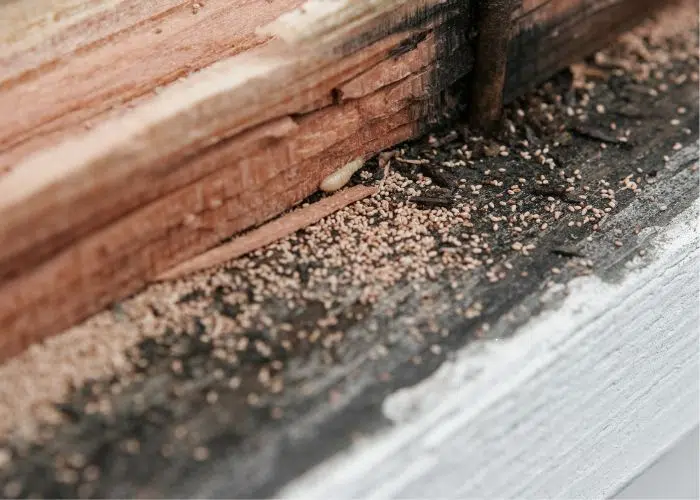
Termites are often called the “silent destroyers” for a reason. These tiny insects can eat away at your home’s structure without you noticing until the damage is done. Understanding the signs of termite infestation early on is crucial to protecting your property and avoiding thousands of dollars in repairs.
In this blog post, we’ll explore how to spot termites, what termite damage signs to look for, how to confirm their presence, and—most importantly—what you should do next. Being proactive can save your structure and your wallet whether you’re a homeowner or a property manager.
Why Early Detection Matters
Termites cause more damage to American homes annually than fires, floods, and storms combined. They are especially dangerous because they work silently and often go unnoticed for months or even years.
Learning how to detect termites early helps reduce the extent of the damage and allows you to get professional help before your property’s structure is compromised.
Common Signs of Termite Infestation
Here are some of the most common signs of termite infestation you should never ignore:
1. Mud Tubes on Walls or Foundation
Subterranean termites build pencil-sized mud tubes along walls, foundations, and crawl spaces. These tunnels protect them from open air as they travel between their nest and a food source. If you spot these, it’s a strong indicator of an active infestation.
2. Hollow or Damaged Wood
Tap on your wooden beams or floors. If they sound hollow, termites may have eaten away the inside. You may also notice blistered or darkened wood, which could indicate termite damage signs.
3. Frass (Termite Droppings)
Drywood termites push their droppings—called frass—out of small holes near their nesting sites. These look like small, grainy wood-colored pellets. Finding frass is a key early sign of termites in the home.
4. Discarded Wings
During their reproductive cycle, termites swarm and shed their wings after mating. You could have an infestation if you notice discarded wings near windows, doors, or vents.
5. Swollen Floors or Ceilings
When termites tunnel through wood, it can cause floors to swell or ceilings to sag. This type of structural damage is often mistaken for water damage but could be caused by termites.
6. Clicking Sounds from the Walls
Soldier termites bang their heads against the walls of their tunnels when disturbed, producing a clicking sound. Worker termites also make soft rustling noises while chewing through wood.
How to Detect Termites in Your Home
While visual cues help, you may still be unsure whether termites are the true culprits. Here’s how to detect termites using some practical and professional methods:
DIY Inspection Tips:
- Use a flashlight to inspect crawl spaces, basements, and attics.
- Probe wood with a screwdriver to check for hollowness.
- Look behind walls using a stud finder to detect gaps caused by tunneling.
Professional Inspection:
For certainty, hire a licensed expert who uses moisture meters, infrared cameras, and trained eyes to locate infestations. Many pest control companies offer free or low-cost inspections, especially in high-risk areas.
Termite Damage Signs to Watch For
By the time you see visible signs of damage, termites may have been working behind the scenes for months. Be alert for:
- Warped door frames and windows that are hard to open
- Peeling paint that resembles water damage
- Sagging or collapsing floors
- Damaged drywall or wallpaper
These are strong termite damage signs indicating that immediate action is necessary.
What to Do if You Suspect Termites
If you notice any of the above signs, don’t panic—but act fast. Here’s what to do next:
1. Don’t Disturb the Colony
Avoid poking into mud tubes or spraying DIY chemicals. This may scatter the termites and make treatment more difficult.
2. Schedule a Professional Inspection
The first thing to do is contact a trusted provider for termite control services. They will confirm the infestation and determine the type of termite involved—dry wood, subterranean, or damp wood—influencing the treatment method.
3. Get a Quote and Treatment Plan
After an inspection, the company will provide a detailed plan for eliminating the colony. Treatment options may include:
- Liquid termiticides around the perimeter
- Foam or dust treatments inside walls
- Fumigation for severe dry wood termite infestations
- Baiting systems to slowly kill off colonies
Your provider should also explain the termite control cost upfront so you can make an informed decision.
4. Prevent Future Infestations
Once treatment is done, consider these preventive tips:
- Repair leaks and reduce wood-to-soil contact
- Store firewood away from the home
- Ensure proper ventilation in crawl spaces and attics
- Schedule annual inspections with a professional termite extermination service
Why Professional Termite Control is Essential
DIY termite control often fails to reach the root of the problem. Store-bought sprays might kill a few termites but won’t eliminate the entire colony or prevent recurrence.
A professional termite extermination service uses proven techniques, offers long-term protection, and gives you peace of mind. Most services also come with a warranty for added security.
Final Thoughts
Termites are a serious threat but can be stopped with awareness and quick action. Knowing the early signs of termites in your home and recognizing termite damage signs can save you money and stress.
If you suspect termites, don’t wait. Contact an expert provider for reliable termite control services and request an estimate on termite control costs so you can start the road to recovery immediately.
